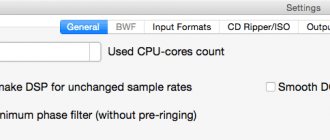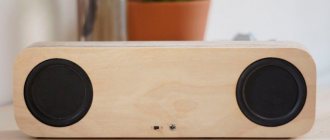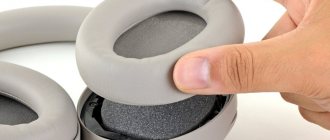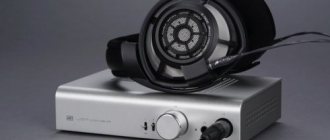Author: hetrick
24 May 2022 16:03
Tags: #dispersion Music acoustics hall premises studio noise
8733
13
Sound-diffusing design.
0
See all photos in the gallery
It's no secret that room acoustics have a significant impact on the sound quality of speaker systems. And it doesn't matter what we're talking about. Whether it's a studio, concert hall or home cinema, proper acoustics are an integral part of the room's design.
Schrader diffuser
An article about Schroeder diffusers, which can significantly improve the acoustics of a room. We will also talk about similar designs in the article. And at the end of the article you will find a calculator for the calculation.
Rice.
1. Using a Schroeder diffuser indoors As audio technology developed, more and more complex sound systems began to be created. More and more time and technological effort are being devoted to the accumulation and processing of sound.
As a result, increasingly high demands are placed on rooms where sound of a wide variety of ranges is recorded and listened to. After all, regardless of where the sound takes place (whether it is a recording studio, a concert hall or a chamber room, a home theater or a special music room), the sound everywhere must be of the highest quality.
However, room designers and acousticians can only absorb, reflect and disperse sound waves (diffusion). Panels or surfaces with sound-absorbing or sound-reflecting properties have become quite widespread. There are designs with a flat surface or a curved one.
However, even absorbed or reflected sound is only a partial solution to the problem.
In various types of small studio spaces or very wide halls, the sound continues to be distorted. To reflect a sound wave is simply to redirect the propagation of the signal, and absorption is to reduce the intensity of the reflection.
But the possibility of dispersion, that is, diffusion, has not gone away, so the attention of specialists was drawn to this property of the sound wave to create special sound-scattering surfaces in various concert venues.
Bedroom
If you are unlucky and you don’t have a special room at home that can be converted into a studio, and you use your bedroom for mixing, then don’t be too upset. Most of the tips described above can be applied just as well to the bedroom.
As with a dedicated mixing room, your main goal is to achieve a fairly neutral sound with a short reverberation time that decays evenly across the frequency spectrum.
Regular rooms and garage spaces are usually too small to add any useful musical color, which means you're better off processing them for as dry a signal as possible, to which you can add artificial space yourself at the mixing stage. using reverb or delay.
- To suppress excessive reverberation, use the same mid/high and low frequency traps described above for the dedicated mixing room.
- Install acoustic baffles to further reduce reflections. Hang blankets around the recording area or construct plywood panels lined with acoustic material to reduce mid- and high-frequency reflections.
- When recording vocals, acoustic guitars, or other acoustic instruments, install a Reflexion Filter or similar around the microphone to reduce reflected sound.
- If you plan to record both acoustic instruments and vocals, you might benefit from some space with an uncovered hard floor. Hard floors reflect sound back into the microphone, adding liveliness to the recording. And at a time when you are not writing anything down, you can temporarily cover this area with a rug.
- Avoid, as much as possible, recording bass synths and bass guitars through microphones in small living rooms. The long waves they produce and the subsequent problems they can cause (some notes are much louder than others) are almost impossible to control at home. It's easier to record bass signals using a direct box and then use amp modeling software to shape the desired sound during the mixing stage.
Tip: You can build your own acoustic baffle using acoustic foam glued to one side of plywood or MDF with simple legs to mount it vertically. The foam side can be used for a cleaner recording, and by flipping the screen you can spice up your recording a bit by adding reflections. These screens can also be used as dividers between musicians playing simultaneously. To improve absorption on both sides of the screen, hang a blanket over it.
What are acoustic diffusers?
Acoustic diffusers are special structures that are used to disperse sound waves of medium and high frequencies, preventing amplitude distortion. Acoustic diffusers maintain sound vibrations inside the room and eliminate fluttering echoes.
Let's look at the process itself in a little more detail. As stated above, acoustic diffusers cannot absorb or reflect sound. Their task is to scatter the sound wave, and in completely different directions. This process can be compared to when a powerful ocean wave encounters a whole pile of blocks of different sizes.
As a result of such a collision, a continuous mass of water is broken into a huge number of splashes of different masses, scattering to the sides at different speeds. Also, a diffuser is capable of “breaking” sound, dispersing it into a mass of sound waves, creating a kind of diffuse field. The room is filled with homogeneous sound energy, allowing you to fully explore the capabilities of the audio system.
It is the principle of breaking (dispersing) a sound wave that underlies devices called acoustic diffusers. And a colossal contribution to the development of this direction was made by the famous German theoretical physicist Manfred Schröder.
His developments in the field of acoustics, devoted to the scattering of reflections from surfaces, became the impetus for the development of acoustic diffusers. The name of the scientist became the name of the Schroeder diffuser, built on his calculations of the mathematical sequence of the maximum sound wavelength.
Criteria for selecting acoustic diffusers
Before purchasing an acoustic diffuser, you need to analyze the space in which it will be installed. It is important to understand the main purpose of the room and its volume. If we take the average formula for calculations, then we will need one acoustic diffuser per cube of the room. The basic criteria for choosing acoustic diffusers are clear, but we should not forget about their correct installation. Experts recommend mounting acoustic diffusers according to the “dead/living corner” principle. The live corner is where the listener is, and the dead corner is located behind the sound source. They should be located opposite each other.
The history of the Schroeder diffuser
Manfred Schröder's research, carried out back in the 70s of the last century, was carried out in concert halls of different configurations. The main reason for this work was the fact that the human ear perceives sound differently in wide and elongated rooms.
Manfred Robert Schroeder, b. in 1926 in Ahlen (North Rhine-Westphalia, Germany).
German physicist and mathematician, professor of physics at the University of Göttingen. Since the mid-50s he has been working in the USA at the Bell Telephone laboratory. In the early 60s, at the invitation of the USSR government, he was a consultant on acoustics of the Kremlin Palace of Congresses. Since the seventies, he has been a member of the US National Stereophonic Broadcasting Committee and a member of the Joint Committee of the US Armed Forces. Schröder recorded the sound of 20 European concert halls through an artificial head. In 1991 he was awarded the Gold Medal of the Acoustical Society of America. Author of three books and 45 inventions. He is interested in languages, computer graphics, skiing and cycling. The scientist came to the conclusion that the human brain perceives sound better when the left and right ears pick up sound waves of different lengths or at different times.
But identical signals are perceived worse.
Thus, the acoustics of rooms with a significant width led to the fact that sound reflections falling into different ears of listeners mainly come from the ceiling and have similar parameters. In more elongated concert halls, sound is reflected from the side walls before reaching the listener. As a result, the reflected sound arrives at the left and right ears with significant differences.
Having carried out a whole range of studies, as well as carrying out the necessary calculations, Manfred Schröder developed a design that has an original sound-diffusing effect. The design, which later received the name of a German acoustician scientist, is one of the types of acoustic diffusers. The basis of this variation of the diffuser is a set of special recesses located in parallel, but having different depths.
To create such a configuration, Manfred Schröder systematized the acoustic parameters of several dozen of the most famous European concert halls. The summarized data showed that most concert halls have wide spaces, which is due to the desire of the organizers to accommodate as many spectators as possible.
The mathematical model he calculated made it possible to create a structure that scatters a sound wave not only in a fairly wide range, but also in a wide variety of rooms. To improve the acoustic parameters of the halls, the sound reflected from the ceiling is redirected to the walls, from where it is picked up by the left and right ears of the audience at different time intervals.
In essence, the Schroeder acoustic system influences the early reflections of the sound wave from obstacles encountered in the sound path. There is a delay in the time of reflections, their arrival time increases, which qualitatively affects the acoustics of a small room.
Monitor locations
The golden rule when placing monitors is to form a roughly equilateral triangle between the speakers and your workspace. The tweeters should be aimed directly at your head in both horizontal and vertical planes. You can increase or decrease the distance between monitors slightly if this helps eliminate bass issues.
Installation of studio monitors
- Make sure the speaker layout and acoustic treatment are as symmetrical as possible. This will create the most balanced stereo image.
- It was once fashionable to mount small monitor speakers in a position parallel to the floor, but unless your speakers are specifically designed for such use, they will perform better in a vertical position, creating a wider listening area and a more uniform frequency response.
- Avoid placing speakers on tables, especially hollow ones, as this will result in strong surface reflections that will also color the sound and reduce stereo imaging and clarity of the mix.
- In cases where installation on a desk is unavoidable, use special insulating panels for monitors. They consist of dense acoustic foam, sometimes with a metal or ceramic surface. Most commercial isolation panels can be tilted up or down to point the tweeters directly at the listener's head.
Insulating panels for monitors
- It is important to provide reliable support for the speakers, since any vibrations generated by the monitor drivers lead to movement of the cabinet, which negatively affects the sound and leads to unclear bass. If you plan to use dedicated monitor stands, consider hollow metal legs that can be filled with sand to add mass and dampen resonances.
Tip: Some powered monitors have switches on the rear panel labeled "whole space", "half space" and "quarter space". They are designed to modify the low frequencies of the speaker to compensate for proximity to walls and corners. "Whole space" mode is optimized for monitors placed away from walls or corners, while "half space" is designed for positions where speakers are close to one wall. The latter mode is used when there is no other choice but to install monitors close to corners.
Rear of monitor
Tip: A good way to determine the best location for the subwoofer, if you use one, is to temporarily place it on the floor where you usually sit. Play a test track with lots of bass (or program a chromatic test sequence) and then listen while sitting on the floor close to the wall. As you change your position, you should notice that the levels of the different bass notes become more or less equal. Once you have found the best location, place the subwoofer there. Usually this place is not in the center and somewhere along the wall. Avoid placing the subwoofer under a table with closed walls, as they create a resonant chamber, resulting in peaks and dips in the lower frequencies.
Diffuser material and application
A Schrader diffuser is, in essence, a phase diffraction grating that splits the incoming sound wave into a wide frequency range.
Moreover, the effect is also observed at a significant angle of incidence.
As noted above, in terms of its design feature, the Schroeder diffuser is represented by a block of special multi-depth cells with the same width.
As a rule, different types of wood are used to make the structure. Fiberboard (fibreboard) is excellent. MDF is fine chips tightly compressed under high pressure and high temperature.
Thinner partitions serve to separate cells. The cell depth itself is calculated by the mathematical sequence of quadratic residues (QRD) from number theory, studied by A. M. Legendre and K. F. Gauss. This is done using an acoustic calculator (see below).
When demonstrating the scattering diagram of a sound wave entering a one-dimensional Schröder diffuser, the result resembles a half-cylinder in shape. The final shape of the diagram depends on the angle of incidence of the sound wave on the diffuser. The law of mirror reflection is triggered.
Rice. 2. Dispersion of sound waves using a Schroeder diffuser.
Rice. 1. Pressure dispersion diagrams of a 1000 Hz sound wave using a diffuser on the left and without on the right.
As you can see in the figure above, the left diagram is the result of the Schroeder diffuser influencing the wave. The right diagram is the reflection of sound in the standard version from a flat surface. The dispersion in the left diagram is much better, which qualitatively affects the acoustic properties of even a small room, making it acoustically much larger.
Mathematical calculations allow acoustic designers to develop structures with specified sound-diffusing parameters designed for a specific room.
With a scientifically proven and calculated solution at their disposal, a number of companies began producing Schroeder acoustic diffusers.
Diffusion
0
Dispersion is used to disperse acoustic energy over a larger area in a room and thereby reduce the concentration and negative impact of direct reflections. To do this, diffusers are used, whose task is to split the sound wave into tens or even hundreds of parts. The problem with this is that their efficiency directly depends on the wavelength of the scattered wave. The longer the wavelength, that is, the lower the frequency, the worse the diffusers cope with the task.
Examples of Schrader diffuser
Acoustic diffuser QRD 7
Thus, in 2006, a Ukrainian acoustic diffuser QRD of the 7th order (p=7) was created. At the production facilities of the Kyiv company, two models of Schroeder diffusers are manufactured, differing in size. One of them, DS6, has parameters of 600x600x220 mm, the second, DS12, is wider with dimensions of 1200x600x220 mm.
Rice. 3. Acoustic diffuser QRD 7.
The material used is Austrian chipboard "Egger". The chipboard is covered with a film (laminated) that imitates valuable wood species. Production is not limited to the two specified sizes. Having the appropriate documentation and calculation formulas, specialists can manufacture an acoustic Schroeder diffuser of any size with the required acoustic characteristics.
Sliding Schrader diffuser
Also available as a demonstration of the capabilities of the Schröder diffuser is Europe's only sliding acoustic dispersion structure. An acoustic device is used to listen to the sound quality of Hi-End equipment in the reference room of the Music Hall store. The Schroeder diffuser is used as an element of acoustic finishing in the Kyiv recording studio "Star Media Sound".
Rice. 4. Sliding acoustic scattering schrader design
Rice. 5. Schrader sliding acoustic dissipation design
The use of an acoustic diffuser allowed the modest size of the rooms used to be conditionally, but significantly “expanded” in terms of acoustic properties.
Ultra-thin Schrader diffuser
A joint American-Chinese team of acousticians has developed a very lightweight yet ultra-thin Schroeder diffuser. The design of the diffuser is 10 times smaller than its larger “brothers”. Such parameters made it possible to use significantly less starting material, and given that wood is used in production, the environmental aspect is obvious.
In addition, the compact design is easier to place in completely different rooms, while not only saving on its production, but also achieving an amazing acoustic effect. A significant advantage compared to larger Schroeder diffusers.
Rice. 6. Ultra-thin Schrader diffuser
Prototypes of an ultra-thin and compact diffuser were 3D printed from plastic. The original designs will be made of natural wood, which has excellent acoustic properties.
Diffuser manufacturing options and materials
Let's look at the three main types of acoustic diffusers currently produced by companies.
Acoustic diffuser HolzAkustika Diffuser 700–2200 Hz
Rice.
7. Acoustic diffuser HolzAkustika Diffuser 700-2200 Hz These diffusers allow you to change the acoustic properties of the structure. This is achieved by the presence of special removable cassettes installed in the frame. Cassettes differ in their functional purpose: absorbers (absorbers) and diffusers (diffusers). The presence of cassettes is due to the ability to disperse sound very balancedly in all directions over a wide range.
If it is necessary to make the sound duller, absorbers are used, and if a drier sound is required, then diffusers are used. By combining two types of cassettes, you can experimentally achieve optimal sound. Replacement and arrangement of cassettes is carried out without structural changes.
The material used takes into account financial capabilities. A more simplified version of cassettes includes acoustic diffusers made of polystyrene foam. More expensive modifications use wood (birch). In the second case, a brighter and clearer sound is obtained. In addition, the appearance of the tree looks more impressive.
Wooden acoustic wooden diffuser ECHOTON Schroeder 400 Hz to 8 kHz
Rice. 8. Acoustic wooden diffuser ECHOTON Schroeder 400 Hz to 8 kHz.
The essence of the design of this modification of the acoustic diffuser is similar to the previous one, only instead of square cell sections, long longitudinal sections are used. However, the early depth of the longitudinal sections-cells is preserved. The dimensions of such a diffuser are 1200x600x150 mm.
The material is made of wood, the species of which is offered to choose from: light Barrick and Wenge oak, light Indian Ebony, milky Liberica, Don walnut.
Pixel acoustic wood diffuser Echoton Pixels 500-3300 Hz
Rice.
9. Acoustic wooden diffuser Echoton Pixels 500–3300 Hz Another version of an acoustic diffuser, only instead of square cassettes or longitudinal cells, pine parallelepipeds are used. Product size 600x600x170 mm.
Acoustic polystyrene foam panel
Experienced professionals prefer acoustic diffusers made of wood. According to the majority, they are valuable for their naturalness and correct reflection of the sound that was developed by nature itself. Some connoisseurs of ideal sound are more impressed by the acoustic polystyrene foam panel, but this is not due to the sound characteristics. Economical price plays a decisive role here. An acoustic polystyrene foam panel is almost 2 times cheaper than a wooden diffuser. Another advantage of acoustic diffusers made of polystyrene foam is the variety of color options. You can create a stylish and bright interior.
Schröder diffuser calculation
A Schröder diffuser consists of a series of cells of varying depths but the same width, housed in a housing made of wood, MDF or other sheet materials. A cross-section of a typical diffuser design (p=7) is shown in the figure on the left. The partitions separating adjacent cells are made of rigid material and have a thickness significantly smaller than the width of the cells.
The diffuser design is based on the mathematical sequence of quadratic residues (QRD) from number theory, explored by A. M. Legendre and K. F. Gauss. The sequence is determined by the following relationship:
Sn = n2 *modulo(p), (1)
where Sn is the sequence of values of the relative depth of the diffuser cells, n is a non-negative integer {0, 1, 2, 3...}, defining the number of the corresponding cell, p is a prime number {2, 3, 5, 7, 11, 13, 17... }, which determines the number of cells in the diffuser (a prime number is a number different from 0 and 1, which is divisible without a remainder only by 1 and itself).
For example, substituting p=17 and n=7 into the indicated ratio, we obtain S7 = 49*modulo(17). Modulo(17) means that the number 17 is sequentially subtracted from 49 until a significant remainder appears. In other words, 17 is subtracted from 49 twice and the remainder 15 is the answer.
Thus, for p=17 we have the following sequence of numbers: S17 = 0, 1, 4, 9, 16, 8, 2, 15, 13, 13, 15, 2, 8, 16, 9, 4, 1; 0, 1, 4…
For large values of n, the sequence is repeated with a period of n=17.
The actual depth of the cells in the diffuser design depends on the value of its design frequency Fo. Schroeder proposed the following formula for calculating the cell depth depending on the selected values of n and p:
dn = Sn with /(Fo*2*p), (2)
where dn is the depth of cell number n, F o is the design frequency of the diffuser, c is the speed of sound in air, p is a prime number (diffuser order) corresponding to the number of cells.
The cell width W is constant and should be small compared to the design wavelength of the diffuser, i.e. Wo value). Schroeder proposed the relation W=0.137*c/Fo in 1979.
It should be noted that the arrangement of cells of different depths established by relation (2) provides a wider frequency range of sound energy dispersion compared to diffusers based on the maximum length sequence (MLS) principle.
At the design frequency, the diffuser has maximum efficiency in dissipating sound energy.
The lower limit of the operating range of the Flow diffuser depends on the size of the deepest cell and is approximately half an octave below the design frequency of the Fo diffuser.
The upper limit of the operating range Fhigh depends on the width of the cells and does not exceed the value Fhigh=с/(2*W).
Partitions separating adjacent cells must be made of thin and rigid material. In practice, the thickness of these partitions has a finite thickness t and therefore in calculations it is necessary to use the sum of values (W + t) instead of the cell width W.
QRD acoustic diffuser calculation calculator
To achieve maximum results when using an acoustic diffuser, you must first calculate the product parameters. To do this, the specified cell sizes (their width and depth) must be specified. In addition, you need to know the effective limits of the frequency range. For calculations, a special online calculator of acoustic diffuser parameters is used. Using this calculator you can calculate the required product size for a given room.
Rice. 10. Approximate cross-section of a QRD Schroeder acoustic diffuser
In the calculator, enter Parameters separated by a dot; it is not necessary to enter a zero before the dot.
An offline calculator can be found at subwoofer-builder.com. The guys prepared a program for calculation.
Installation of acoustic diffusers
The main placement of acoustic modules is the ceiling and side walls of the room. To determine the optimal position to achieve maximum effect, an ordinary mirror is useful. By moving the mirror along the side walls, you need to see in it the reflection of the speakers emitting a sound wave.
Also, where the diffusers are fixed on the side walls and ceiling depends on how intensively the room will be used. For example, in recording studios and rehearsal rooms, maximum sound quality is achieved with an even distribution of diffuser modules.
Sound control rooms have a different placement option. The “living angle-dead angle” principle applies here. The main part of the sound absorbers is located on the ceiling, side walls and behind the sound emitters (speakers). And on the opposite side of the room there are sound wave scatterers - diffusers.
It has been empirically found that warm and pleasant sound is achieved when organic materials are used indoors. In particular, a room equipped with oak parquet or cork flooring, as well as such ceilings, are optimal conditions for achieving excellent acoustics. But concrete walls or glass surfaces, on the contrary, are extremely unfavorable, as they distort the sound.
In addition, it is necessary to take into account the presence of furniture in the room. So, an ordinary bookshelf can act as a natural diffuser, that is, it dissipates sound. But a soft sofa is a classic absorber of not only dust, but also sound waves. That is why the correct combination of furniture, flooring and ceiling materials, as well as the placement of diffusers is the key to high acoustic parameters of the room.
Impressions from people
Mexkb (Nikita)
A thorough analysis, but from the practice of use I would note one natural disadvantage. If you use wood in the manufacture of a diffuser for its acoustic properties, then the resulting product will be quite impressive in weight.
In my case, it was necessary to close the front wall with dimensions of about 180x120x40. After some calculations, it turned out that the total weight of the structure would have pulled 100 kg. This is a bit much, especially considering that the walls are equipped with soundproof cladding. Drywall is unlikely to successfully withstand such a load.
This is why I don’t like the idea of making diffusers of this type from timber - the weight is very large. I figured that in order to cover the front wall (available space 180x120x40) the structure would have to weigh over a hundred kg. Considering that my walls have soundproofing cladding, it is dangerous to attach such weight to drywall. Leaving them standing on top of each other on the cabinet is even more dangerous, given a small child. Therefore, I have design ideas for hollow contents, but I have not yet gotten to the point of implementing them (high labor intensity of manufacturing).
It would be interesting to calculate the Schroeder acoustic diffuser, but with a hollow content. There would be a compromise option. Here, for example, is the case with foam rubber.
Gepard
I'll tell you about my experience using Schroeder diffusers. Homemade acoustic systems are available (height 40 cm). I placed the diffusers on the wall and placed the speakers under them. There were two more horizontal diffusers; there was nowhere to mount them on top, so I just put one on the floor. The second remained to be “sticked” to the vertical ones. The result was a rather cumbersome “system”.
The result of the "experiment". I listened to several musical instrumental compositions, as well as jazz concerts. The impressions are wonderful. The first thing I noticed was the amazing feeling of a significant increase in space; the room seemed to “breathe.” The boundaries of the instruments seemed to melt away, and point localization decreased. The perception of sound becomes much more comfortable. Very satisfied.
WLM audio maniac
When installing the diffusers, Schroeder noted a number of interesting features that had not previously been noticed. Namely, the spatial separation of instruments was noticeably better; even the singer’s singing along with him became clearly audible. Now you will have to listen to all your favorite compositions, as the effect is amazing.
Grafomaniac
From my experience of experimenting with acoustic diffusers, I can note that diffusers with cylindrical HR are best suited for side walls and floors. (due to greater distance). It is better to place spherical ones behind or around the acoustics.









